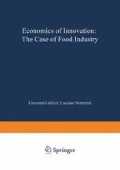Summary
Processing, product and organisational innovations are to be found everywhere in the agro-food industries. The influence of upstream industries on techno-economic supply conditions of agro-food activities favour processing innovations, which tend to reduce costs and prices.
Processing innovations work by improving productivity, improving product quality, increasing product availability, and along technological trajectories (economic and technological trade-offs). They are not usually major innovations. The process is improved by a lot of fringe changes of various kinds. Or, sometimes the technical established system is reconfigurated by an “architectural innovation”. The arguments are applied to the case of the bread production.
Access this chapter
Tax calculation will be finalised at checkout
Purchases are for personal use only
Preview
Unable to display preview. Download preview PDF.
References
Agreste, 1993, “L’ Industrie agro-alimentaire et l’Innovation”, Cahiers, n. 13, pp. 27–34.
Boulin P., 1994, L’enjeu des normes, in Universalia, éditions Encyclopaedia Universalis, pp. 228–230.
Bouhsina Z., 1991, Technologies Nouvelles et Industrielles Traditionnelles: le Cas des Biotchnologies et des Industries Agro-Alimentaires, Thèse de l’Université des Sciences et Techniques de Lille, June, p. 410.
Chamberlain N., Collins T.H., Elton G.A.H., Cornford S.J., 1962, The Chorleywwood Bread Process, Report 62, British Baking Industries Research Association, Chorleywwood.
Cnerna, 1948, Les Journées Scientifiques sur le Pain, éditions du CNRS, Paris, p. 464.
Dosi G., 1988, “Sources, Procedures, and Microeconomics Effects of Innovation”, Journal of Economie Literature, September, pp. 1120–1171.
Dubois M., 1984, “L’évolution de la force boulangère des farines exprimée par le W depuis trente ans”, Industries des Céréales, January-February.
Guilbot A., 1979, Perspectives scientifiques et conclusions sur les blés et le pain en France, in J. Bure, “Actes du Colloque du CNERNA”, Edited by CNRS, Paris, pp. 235–241.
Henderson R.M., Clark K.B., 1990, “Architectural Innovation: the Reconfiguration of Existing Product Technology and the Failure of Established Firms”, Administrative Science Quarterly, n° 35, pp. 9–30.
Hudry F., Législation, in R. Guinet, B. Godon (eds), 1994, La Panification Française, Ed. Lavoisier, Paris, pp.45–60.
Hy M., Nicolas F., 1992, “La Diffusion de la Surgélation dans les Systèmes Productifs Agro-alimentaires”, Innovation, Changement Technique et Agroalimentaire, INRA, CNRS, Ministère de la Recherche, Paris, pp. 111–125.
Kline S.J., Rosenberg N., 1986, “An Overview of Innovation”, in Landau R., Rosenberg N. (eds), The Positive Sum Strategy, National Academy Press, Washington, pp. 275–306.
Maunder P., 1955, The Bread Industry in The United Kingdom, University of Nottingham, p. 111.
Menard C., 1994, “L’Innovation Organisationnelle, Elements de Réflexion”, Revue d’Economie Industrielle, pp. 1–26.
Nicolas F., 1993, “L’adaptation des Productions aux Demandes Alimentaires”, Agricultures et Société, Association Descartes, éditions INRA, Paris, pp. 161–167.
Nicolas F., 1994, “Evolution de la Consommation, des Techniques et des Structures de Production”, in Guinet R., Godon B. (eds), La Panification Française, Ed. Lavoisier, Paris, pp. 62–95.
Panschar W.G., 1956, An Economic History of the Baking Industry to 1930, North-Western, Illinois, p. 299.
Poitrenaud B., 1994, La Levure, in Guinet R., Godon B. (eds), La Panification Française, Ed. Lavoisier, Paris, pp. 165–201.
Pujol R., 1985, Nicolas Appert, l’Inventeur de la Conserve, Ed. Denoël, Paris, p. 206.
Silverberg G., 1991, “Adoption and Diffusion of Technology as a Collective Evolutionary Process”, Technological Forecasting and Social Change, n° 39, pp. 67–80.
Yul M., 1984, The Quality of Frozen Food, Academic Press, London, p. 292.
Author information
Authors and Affiliations
Editor information
Editors and Affiliations
Rights and permissions
Copyright information
© 1996 Physica-Verlag Heidelberg
About this paper
Cite this paper
Nicolas, F. (1996). Combined Roles of Process and Product Innovations in the Food Industries. In: Galizzi, G., Venturini, L. (eds) Economics of Innovation: The Case of Food Industry. Contributions to Economics. Physica-Verlag HD. https://doi.org/10.1007/978-3-642-50001-5_21
Download citation
DOI: https://doi.org/10.1007/978-3-642-50001-5_21
Publisher Name: Physica-Verlag HD
Print ISBN: 978-3-7908-0911-4
Online ISBN: 978-3-642-50001-5
eBook Packages: Springer Book Archive

